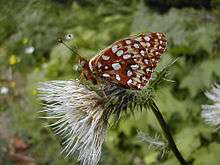Speyeria zerene hippolyta
| Oregon Silverspot | |
|---|---|
 | |
| Scientific classification | |
| Kingdom: | Animalia |
| Phylum: | Arthropoda |
| Class: | Insecta |
| Order: | Lepidoptera |
| Family: | Nymphalidae |
| Tribe: | Heliconiini |
| Genus: | Speyeria |
| Species: | S. zerene |
| Subspecies: | S. z. hippolyta |
| Trinomial name | |
| Speyeria zerene hippolyta W. H. Edwards, 1879 | |
The Oregon Silverspot (Speyeria zerene hippolyta) is a threatened butterfly that is found the U.S. states of California and Oregon.[1] It is a subspecies of Speyeria zerene.
The Oregon Silverspot used to inhabit suitable coastal habitat from northern California, through Oregon, into southern Washington. It can now only be found in the wild at a few remaining sites in California and Oregon.[2] Conservation sites include Cascade Head and the Rock Creek Wilderness[3] in Oregon. The butterfly can also be found at Mount Hebo and Clatsop Plains in Oregon and at Lake Earl in California. [2]
In Washington, the butterfly is listed as endangered under that state's legislation, though it is now reported extirpated from this state. California and Oregon do not have endangered species statutes that allow the listing of insect species, so despite its precarious status, the Oregon Silverspot has no protection in these states. It is on the Special Animals list created by the California Department of Fish and Game.[2]
Speyeria zerene hippolyta is in a clade of three closely related subspecies. In suitable habitat along the U.S. Pacific coast, it is the northermost one found. Further south, Myrtle's Silverspot (Speyeria zerene myrtleae) had a range along the coast from San Mateo County to Sonoma County, California, and Behren's Silverspot (Speyeria zerene behrensii) had a range along the northern California coast.[2]
The coastal habitats used by the butterfly were kept in an early successional state by high wind, salt-spray and occasional wildfires, providing the open conditions required by the hookedspur violet (Viola adunca) which is the butterfly's larval hostplant. In recent years, although the winds and ocean salt-spray continue to limit other vegetation growth, the wildfires have been suppressed due to modern development in this habitat. The original habitat of open meadows has, over time, been replaced by forest habitat.[2]
Researchers have been testing methods of maintaining and restoring the grassland habitat in coastal preserves, these include prescribed fire. As it does take several years for the hookedspur violet to reach maturity a "stop-gap measure" is underway. A team consisting of the Oregon Nature Conservancy, the U.S. Fish and Wildlife Service, Lewis and Clark College and the Oregon Zoo gather female butterflies for captive rearing. The captive-rearing projects are underway at the college and the Oregon Zoo in Portland and the Woodland Park Zoo in Seattle. After being hatched and raised at the college and the zoos, the young are reintroduced as pupae to the wild to augment the existing populations.[4][2] After the release of nearly 450 silverspots at Mount Hebo in 2016, Karen Lewis, a zoo conservation research associate, said in a statement, "The goal of the recovery program is to help each population grow large enough to be self-sustaining, if it weren't for this program, three of the five remaining silverspot populations would likely be extinct."[5]
Pelican Pub & Brewery in Pacific City donates a portion of the proceeds from its Silverspot IPA to silverspot conservation efforts.[6]
See also
References
- ↑ "Species Profile: Oregon Silverspot butterfly (Speyeria zerene hippolyta)". U.S. Fish and Wildlife Service. Retrieved April 12, 2014.
- 1 2 3 4 5 6 Black, S. H.; D. M. Vaughan (2005). "Species Profile: Speyeria zerene hippolyta.". The Xerces Society for Invertebrate Conservation. Retrieved May 18, 2016.
- ↑ Rock Creek Wilderness - Wilderness.net
- ↑ Cascade Head at the Wayback Machine (archived January 26, 2007)
- ↑ Kale Williams. "Hundreds of endangered silverspot butterflies released near Oregon coast". The Oregonian/OregonLive. Retrieved Aug 16, 2016.
- ↑ "Silverspot IPA". Pelican Pub & Brewery. Retrieved April 12, 2014.
External links
- Oregon Silverspot Butterfly, Arcata Fish and Wildlife Office
- Butterflies of the Northwest, Woodland Park Zoo
